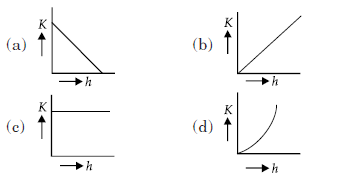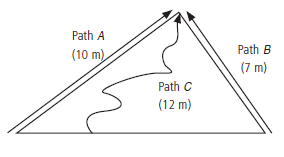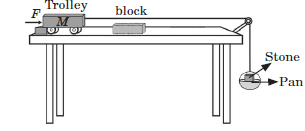Refer to CBSE Class 9 Science Work and Energy MCQs Set B provided below available for download in Pdf. The MCQ Questions for Class 9 Science with answers are aligned as per the latest syllabus and exam pattern suggested by CBSE, NCERT and KVS. Chapter 10 Work and Energy Class 9 MCQ are an important part of exams for Class 9 Science and if practiced properly can help you to improve your understanding and get higher marks. Refer to more Chapter-wise MCQs for CBSE Class 9 Science and also download more latest study material for all subjects
MCQ for Class 9 Science Chapter 10 Work and Energy
Class 9 Science students should refer to the following multiple-choice questions with answers for Chapter 10 Work and Energy in Class 9.
Chapter 10 Work and Energy MCQ Questions Class 9 Science with Answers
Question: Which of the following does not possess the ability to do work not because of motion ?
a) a sparrow flying in the sky
b) a sparrow moving slowly on the ground
c) a sparrow in the nest on a tree
d) a squirrel going up a tree
Answer: C
Question: A rocket rises up vertically. What happens to its potential energy?
a) It increases.
b) It initially increases then decreases.
c) It initially decreases then increases.
d) It increases, till it becomes maximum.
Answer: d
Question: A rod of mass m and length l is lying on a horizontal table. Work done in making it stand on one end will be
a) mgl
b) mgl/2
c) mgl/4
d) 2mgl
Answer: b
Question: The momentum of a bullet of mass 20 g fired from a gun is 10 kg.m/s. The kinetic energy of this bullet in kJ will be :
a) 5
b) 1.5
c) 2.5
d) 25
Answer: C
Question: In which of the following cases is the potential energy of a spring minimum?
a) When it is compressed
b) When it is extended
c) When it is at its natural length.
d) When it is at its natural length but is kept at a height h above the ground
Answer: c
Question: A girl weighing 400 N climbs a vertical ladder. If the value of g be 10 m s–2, the work done by her after climbing 2 m will be :
a) 200 J
b) 800 J
c) 8000 J
d) 2000 J
Answer: B
Question: Column-I Column-II
(P) Kinetic energy 1. mgh
(Q) Power 2. 1/2mv2
(R) Potential energy 3. mv
(S) Momentum 4. W/t
a) P-2, Q-4, R-1, S-3
b) P-3, Q-2, R-4, S-1
c) P-3, Q-4, R-2, S-1
d) P-1, Q-4, R-3, S-2
Answer: a
Question: At sea level, a nitrogen molecule in air has an average translational kinetic energy of 6.2 × 10–21 J. Its mass is 4.7 × 10–26 kg. If the molecule shoots up straight without resistance,it will rise to a height of
a) 1.35 km
b) 13.5 km
c) 135 km
d) 1350 km
Answer: b
Question: A force of 7 N acts on an object. The displacement is, say 8 m, in the direction of the force. Let us take it that the force acts on the object throughout the displacement. What is the work done in this case?

a) 56 J
b) 80 J
c) 90 J
d) 100 J
Answer: a
Question: When the momentum of a body is increased by 100%, its K.E. increases by
a) 100%
b) 200%
c) 300%
d) 400%
Answer: c
Question: The work done on an object does not depend on the :
a) displacement
b) angle between force and displacement
c) force applied
d) initial velocity of the object
Answer: D
Question: The power of a water pump is 2 kW. If g = 10 m/s2, the amount of water it can raise in 1 min to a height of 10 m is
a) 2000 litre
b) 1000 litre
c) 100 litre
d) 1200 litre
Answer: d
Question: A car is accelerated on a levelled road and attains a speed of 4 times its initial speed. In this process, the kinetic energy of the car :
a) does not change
b) becomes 4 times that of initial kinetic energy
c) becomes 8 times that of initial kinetic energy
d) becomes 16 times that of initial kinetic energy
Answer: D
Question: A body rolls down on inclined plane, it has
a) only kinetic energy
b) only potential energy
c) both kinetic energy and potential energy
d) neither kinetic energy nor potential energy
Answer: c
Question: In case of negative work, the angle between the force and displacement is :
a) 0°
b) 45°
c) 90°
d) 180°
Answer: D
Question: Which of the following graph best represents the kinetic energy (K.E) of a freely falling body and its height h above the ground?

Answer: a
Question: A car is accelerated on a levelled road and acquires a velocity 4 times of its initial velocity. During this process, the potential energy of the car :
a) does not change
b) becomes twice that of initial potential energy
c) becomes 4 times that of initial potential energy
d) becomes 16 times that of initial potential energy
Answer: A
Question: Each of the following statement describes a force acting. Which force is causing work to be done
a) the weight of a book at rest on a table
b) the pull of a moving railway engine on its coaches
c) the tension in an elastic band wrapped around a parcel
d) the push of a person’s feet when standing on the floor
Answer: B
Question: An iron sphere of mass 10 kg has the same diameter as an aluminium sphere of mass 3.5 kg. Both the spheres are dropped simultaneously from a tower. When they are 10 m above the ground, they have the same :
a) acceleration
b) momentum
c) potential energy
d) kinetic energy
Answer: A
Question: The speed of a motor bike decreases by 4 times. Its kinetic energy will decrease by
a) four times
b) eight times
c) sixteen times
d) thirty two times.
Answer: c
Question: Water stored in a dam possesses :
a) no energy
b) electrical energy
c) kinetic energy
d) potential energy
Answer: D
Question: A girl is carrying a school bag of 3 kg mass on her back and moves 200 m on a levelled road. If the value of g be 10 m/s2, the work done by the girl against the gravitational force will be :
a) 6000 J
b) 0.6 J
c) 0 J
d) 6 J
Answer: C
Question: A car is accelerating up a slope. What are the changes in its kinetic energy and potential energy as it is moving up the slope?
Kinetic energy Potential energy
a) decrease decrease
b) decrease increase
c) increase increase
d) increase decrease
Answer: c
Question: There are three paths A, B and C leading to the top of the hill as shown. Assuming that the friction of the ground is negligible, which of the following statements is true?

a) All three paths require the same amount of energy to reach the top.
b) Path B requires the least energy to reach the top.
c) Path C requires most energy to reach the top.
d) Path B requires more energy than path A to reach the top.
Answer: a
Question: A man exerts a 80 N force on a load of mass 6 kg along a rough surface. The frictional force acting on the load is 20 N.

Given that the mass moves 5 m horizontally in 30 s, what is the useful power developed by the man?
a) 10 W
b) 13 W
c) 78 W
d) 300 W
Answer: a
Question: Set up the apparatus as shown in figure.

When stone is placed in the pan, trolley moves forward) If you have two stones of masses 10 kg and 5 kg, then in which of the following cases, the block placed in path of trolley suffers maximum displacement? (Assume that trolley stops after hitting the block.)
a) When stone of 5 kg is placed in the pan.
b) When stone of 10 kg is placed in the pan.
c) When both the stone are placed in the pan.
d) When the pan is empty.
Answer: c
| CBSE Class 9 Science Atoms and Molecules MCQs Set A |
| CBSE Class 9 Science Atoms and Molecules MCQs Set B |
| CBSE Class 9 Science Atoms and Molecules MCQs Set C |
| CBSE Class 9 Science Animal Tissues MCQs |
| CBSE Class 9 Science Tissue MCQs Set A |
| CBSE Class 9 Science Tissue MCQs Set B |
| CBSE Class 9 Science Tissue MCQs Set C |
| CBSE Class 9 Science Motion MCQs Set A |
| CBSE Class 9 Science Motion MCQs Set B |
| CBSE Class 9 Science Motion MCQs Set C |
| CBSE Class 9 Science Motion MCQs Set D |
| CBSE Class 9 Science Work and Energy MCQs Set A |
| CBSE Class 9 Science Work and Energy MCQs Set B |
| CBSE Class 9 Science Work and Energy MCQs Set C |
| CBSE Class 9 Science Sound MCQs Set A |
| CBSE Class 9 Science Sound MCQs Set B |
| CBSE Class 9 Science Sound MCQs Set C |
| CBSE Class 9 Science Improvement In Food Resources MCQs Set A |
| CBSE Class 9 Science Improvement In Food Resources MCQs Set B |
MCQs for Chapter 10 Work and Energy Science Class 9
Expert teachers of studiestoday have referred to NCERT book for Class 9 Science to develop the Science Class 9 MCQs. If you download MCQs with answers for the above chapter you will get higher and better marks in Class 9 test and exams in the current year as you will be able to have stronger understanding of all concepts. Daily Multiple Choice Questions practice of Science will help students to have stronger understanding of all concepts and also make them expert on all critical topics. After solving the questions given in the MCQs which have been developed as per latest books also refer to the NCERT solutions for Class 9 Science. We have also provided lot of MCQ questions for Class 9 Science so that you can solve questions relating to all topics given in each chapter. After solving these you should also refer to Class 9 Science MCQ Test for the same chapter.
You can download the CBSE MCQs for Class 9 Science Chapter 10 Work and Energy for latest session from StudiesToday.com
Yes, the MCQs issued by CBSE for Class 9 Science Chapter 10 Work and Energy have been made available here for latest academic session
You can find CBSE Class 9 Science Chapter 10 Work and Energy MCQs on educational websites like studiestoday.com, online tutoring platforms, and in sample question papers provided on this website.
To prepare for Chapter 10 Work and Energy MCQs, refer to the concepts links provided by our teachers and download sample papers for free.
Yes, there are many online resources that we have provided on studiestoday.com available such as practice worksheets, question papers, and online tests for learning MCQs for Class 9 Science Chapter 10 Work and Energy

